
7 super-easy hacks to handle your waste like a ninja
written by
Sortin Team
November 6, 2023
Urban Indians produce more than 0.5 kg of waste every day. This number will only go up as our income and population goes up, with our municipal solid waste expected to increase 7x over the next 30 years. Even as we continue to add on to our waste processing capacity, we need to drive more efficiency in our waste collection and handling to meet up with the demand. It is widely accepted that waste segregation is key to enhance that efficiency and the best segregation happens at the source.
Here are the seven key steps we can take to make its processing as seamless as possible.
1. Segregate your food waste
We must have a separate dustbin just for food waste, including leftover and discarded food. We must not mix the food waste with any food packaging and containers (even paper ones). When set aside without any non-biodegradable material, food waste can be easily converted to a valuable resource through compositing. Read how you can easily compost here.
2. Rinse your take-out boxes and food containers
Food and grease remains significantly reduce the recyclability of food packaging and containers. We must try to wash food boxes and containers with soap before discarding, but even rinsing them clean with water also goes a long way in easing the whole recycling process, including for manual handlers.
3. Be careful with your hazardous waste
We regularly use a lot of products containing toxic chemicals like pest repellents, tube lights etc. and it is important to handle them separately while disposing as they risk contaminating the environment. These items must be packed in a separate bag and tagged as hazardous, while disposing with the authorized waste picker.
4. Safely dispose your sanitary waste
Sanitary waste items like diapers, sanitary napkins, paper tissues etc. risk contaminating and infecting the waste supply chain, the waste handlers and the environment, if not disposed properly. The sanitary waste must be discarded separately from other waste items and should be disposed in a separate bag.
5. Fish out the unrecyclable waste
Recycling many of our commonly used items like chips packets, greased paper, festival lights, egg trays, ketchup sachet etc. is either technically or commercially unviable. The best possible disposal for these items is incineration or using them to fuel waste to energy plants. We must be mindful of using these products and we should dispose these items in a separate bag.
6. Recycle your dry waste
Everything apart from food, hazardous, sanitary and unrecyclable waste is our dry waste, including e-waste. All of this can and must be recycled. Robust government efforts complemented by an efficient informal network of ragpickers and scrap dealers ensures that India recycles a significant portion of its recyclable waste. Although we can make this whole process much smoother by disposing our dry waste separately with authorized waste picker or scrap dealer.
7. Recover from your mistakes
Handling waste optimally is difficult, time-consuming and not always straightforward. Making mistakes is unavoidable and sometimes the only option. We shouldn’t let a mistake set us back and we must continue on our journey to becoming a ninja waste handler.

7 steps to becoming a ninja waste handler
As these hacks improve the efficiency of how your waste is handled, reducing our waste must always remain the top most priority. While reducing consumption directly contributes to reducing our waste, we can also cut down on our waste significantly by purchasing from truly sustainable alternatives (like groceries in reusable jars, thrifting clothes etc.), making small behavioural changes (like carrying our own bottles, composting etc.) or saying no to unrecyclable products (like ketchup sachet, plastic straws etc.).